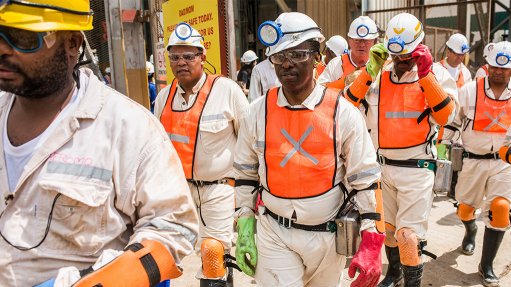
ENGAGING MINING COMPANIES The Department of Mineral Resources has held talks with sevral mining companies in an attempt to address the challenges plaguing the industry in South Africa
Photo by: Bloomberg
The planned introduction of new mining technologies, such as mechanisation, should take the socioeconomic conditions in South Africa into account – particularly to enhance job opportunities in the mining industry and the country, says the Department of Mineral Resources (DMR).
These employment objectives are not limited to South Africa, however. The African continent, regarded as the last frontier of the mining industry, battles various socioeconomic challenges, with more than 40% of people in sub-Saharan Africa living in absolute poverty.
Mineral Resources Minister spokesperson Martin Madlala notes that the advancement of mining in Africa is necessary and in line with the objectives of the African Mining Vision, which was adopted by African Union States in 2009 and aims to integrate mining into developmental policies at local, national and regional levels.
Therefore, as the mining industries in East and Central Africa hum with activity, the development and growth of those industries is welcomed by South Africa and not regarded as competition, he advises.
Madlala emphasises that the development of a mineral resources industry must be aligned with a country’s developmental objectives, which include innovation and technology.
“Some of our mines – especially gold mines – still have large reserves at depths in excess of 4 km, which necessitates that we constantly evaluate appropriate technological interventions that are needed to access those resources,” he points out.
However, mining operations should be based on sound research and development (R&D) fundamentals and continuous skills development, he stresses.
Further, Madlala notes that, while mechanisation is a viable option, it is not the be-all and end-all for South African or African mining. “There are mines that are already mechanised. However, some mechanisation attempts have not been successful, suggesting that improved efficiency does not necessarily depend on mechanisation.”
He adds that, in terms of mechanisation efforts, science councils and institutions in the mining sector – the Council for Geoscience, Mintek, the Council for Science and Industrial Research, the Mine Health and Safety Council and the Mining Qualification Authority – will continue to play an important role.
“. . . companies should also complement government efforts by also continuously training and upskilling workers as part of their business operations,” Madlala says.
South African Overview
Mining remains a ‘sunrise’ industry, owing to the vast value of mineral reserves and exploration prospects.
Although the industry is under pressure because of sustained low commodity prices, “it is the DMR’s considered view that the industry is cyclical in nature, with an upturn on the horizon”, Madlala states.
In addition to the Mining Phakisa process – which was authorised by President Jacob Zuma to address mining investment – the DMR, in collaboration with industry stakeholders, is implementing the Declaration on Mining Industry Commitment to Save Jobs and Ameliorate the Impact of Job Losses, which was signed in August.
Madlala explains that the DMR frequently interacts with the financial community and participates in conferences to promote investment in the sector, adding that it has engaged local investors, as well as investors in Canada, China, Australia and England, in the past year.
The estimated value of South Africa’s mineral resources, excluding energy commodities and subsequent major discoveries, amounts to $2.5-trillion, Madlala says, citing the ‘2010 Metals and Mining Strategy’ report compiled by Citi Bank.
“South Africa’s unique geology presents potential for the discovery and development of globally competitive mineral and petroleum deposits in respect of platinum-group metals, coal, manganese and upstream oil and gas in the form of shale gas.”
Madlala suggests that local mineral beneficiation, which forms part of the National Development Plan, will also provide opportunities for the country in terms of advancing industrialisation.
Despite the challenges it faces, the mining industry remains the mainstay of the South African economy, he notes, reasoning that the “current initiatives of government, which include R&D, will without doubt propel the industry on a new trajectory of inclusive growth”.